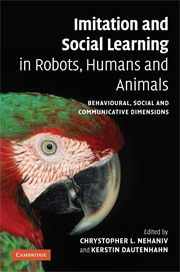 Imitation and Social Learning in Robots, Humans and Animals
Imitation and Social Learning in Robots, Humans and Animals Book contents
- Frontmatter
- Contents
- List of plates
- List of figures
- List of tables
- List of contributors
- Introduction: the constructive interdisciplinary viewpoint for understanding mechanisms and models of imitation and social learning
- Part I Correspondence problems and mechanisms
- Part II Mirroring and ‘mind-reading’
- Part III What to imitate?
- Part IV Development and embodiment
- Part V Synchrony and turn-taking as communicative mechanisms
- Part VI Why imitate? – Motivations
- Part VII Social feedback
- Part VIII The ecological context
- Index
- Plate section
Part II - Mirroring and ‘mind-reading’
Published online by Cambridge University Press: 10 December 2009
- Frontmatter
- Contents
- List of plates
- List of figures
- List of tables
- List of contributors
- Introduction: the constructive interdisciplinary viewpoint for understanding mechanisms and models of imitation and social learning
- Part I Correspondence problems and mechanisms
- Part II Mirroring and ‘mind-reading’
- Part III What to imitate?
- Part IV Development and embodiment
- Part V Synchrony and turn-taking as communicative mechanisms
- Part VI Why imitate? – Motivations
- Part VII Social feedback
- Part VIII The ecological context
- Index
- Plate section
Summary
Mirrors, mirror neurons and mirroring the behaviour of others all clearly relate to different types of matching. Could mirror-like mechanisms allow us to understand and to generate imitative behaviour? If so, how?
The phrase, ‘Monkey see, monkey do’ is still being used in public terms to dismiss any behaviour where an animal copies or mirrors what another animal is doing, despite the fact that the research fields of social learning and imitation in humans, animals and, more recently, robotics, have been flourishing, providing rich evidence for the importance of imitation and social learning in social development, skills learning, culture, etc. Similarly, in computer science and robotics the term ‘imitation’ can be misunderstood easily as simply copying computer programmes e.g. from one machine/robot to another. However, imitation in biological systems is not realized as copying ‘behaviour programmes’ from one animal to another: even in the hypothetical situation that brain waves could be directly transmitted and exchanged between, for example, humans, they would still have to be perceived and interpreted, they could not be ‘loaded’ directly into the neural structure of another organism, very different from a particular piece of software where numerous copies can be produced and installed on various computers. Metaphors borrowed from computer science often fail in the realm of biological systems, and ‘copying’ or ‘imitation’ is a good example.
- Type
- Chapter
- Information
- Imitation and Social Learning in Robots, Humans and AnimalsBehavioural, Social and Communicative Dimensions, pp. 67 - 70Publisher: Cambridge University PressPrint publication year: 2007


